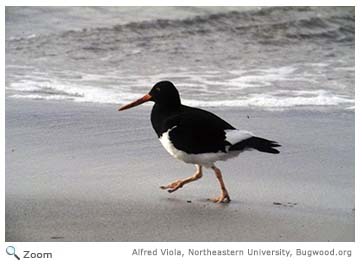Haematopodidae - oystercatchers
 Oystercatchers are shorebirds with long, strong, pointed orange or red bills that they use to open oysters and other bivalves. They also eat fish and crabs. Most species are black or dark brown with white undersides. Males and females look alike. Oystercatchers live on coasts in all areas of the world, except for the Arctic and Antarctic regions. Oystercatchers are shorebirds with long, strong, pointed orange or red bills that they use to open oysters and other bivalves. They also eat fish and crabs. Most species are black or dark brown with white undersides. Males and females look alike. Oystercatchers live on coasts in all areas of the world, except for the Arctic and Antarctic regions.
Oystercatchers nest in a scrape on the ground. The female lays 1-3 eggs. Both the female and the male incubate the eggs. During the breeding season, oystercatchers are very territorial.
There species in this family include the black oystercatcher, the South Island oystercatcher, the sooty oystercatcher, the pied oystercatcher, the African oystercatcher, the Eurasian oystercatcher, and the American oystercatcher. One species, the Canarian black oystercatcher, is extinct.
World Status Key
 Least Concern Least Concern  Near Threatened Near Threatened  Vulnerable Vulnerable  Endangered Endangered  Critically Endangered Critically Endangered  Extinct in Wild Extinct in Wild  Extinct Extinct
Status taken from ICUN Redlist. If no status is listed, there is not enough data to establish status, or there is no status data for the species.
US Status Key
 Threatened in US Threatened in US  Threatened in NH Threatened in NH  Endangered in US Endangered in US  Endangered in NH Endangered in NH  Introduced Introduced
Status taken from US Fish and Wildlife and NH Fish and Game
|

